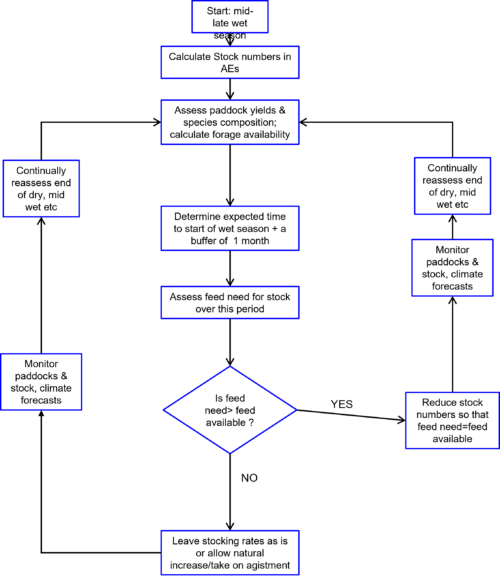When to adjust stocking rates
The primary stocking rate adjustment point should be around the end of the wet season, as this is when there is the greatest certainty about how much forage will be available for the year (i.e. there is little chance of further growth) and how long it has to last (i.e. the 6 to 8-month dry season).
Other logical secondary stocking rate adjustment points are in the mid and late dry season and in the early to mid-wet season.
How to adjust stocking rates
Adjust stocking rates in a cautious, flexible manner as seasons vary, based on available forage, animal performance and seasonal conditions.
Where appropriate (i.e. later in the dry season when accuracy is highest), climate forecasts should also be taken into account—particularly when an El Nino is forecast.
Calculating stocking rates
Stocking rates are usually set based on a forage budget. This is done by first estimating the amount of feed in a paddock based on photo standards or some other method (see ‘Tools and resources’ section).
Where tree cover is low, satellite-based tools can also be very helpful.
A calculation is then done to estimate the number of animals a paddock can support for a defined period of time (the dry season plus a buffer) as explained later in this document.
The flow diagram shown in Figure 2 lays the process out in a series of easy steps.
Other useful means of adjusting stocking rates are:
- The ‘Shepherd Carrying Capacity Ready Reckoner’ (Upper Burdekin only)
- Grazing charts as used by Resource Consulting Services Australia
Even if not running a rotational grazing system, regularly calculating grazing days per hectare in relation to rainfall is a very good way of keeping check on stocking rates relative to seasonal conditions.
Whatever the method used, it is important to set upper limits on stocking rates in even the best seasons to prevent overgrazing. As an example, never more than 20% above LTCC.
Changes in stocking rate should always minimise risk i.e. cut stocking rates sharply (e.g. by 20-40% or more) with the approach of poor seasons but increase stocking rates gradually (e.g. 10-15%) during good seasons. The degree of change will also depend on:
- Current stocking rates relative to LTCC.
- Land condition trends and the risk of degradation (if pasture condition is declining or recovering post drought and/or seasonal outlooks are negative, err on the side of caution).
Remember: Stocking rates based on forage budget estimates are only broad guides — use with caution and adjust numbers as needed.
Aside from the primary decision point at the end of the wet season, it is also important to:
- constantly assess available feed and animal condition as described above
- set additional decision points for early to mid-February and Easter in case the wet season fails and further cuts are required
- monitor ongoing climate forecasts.


